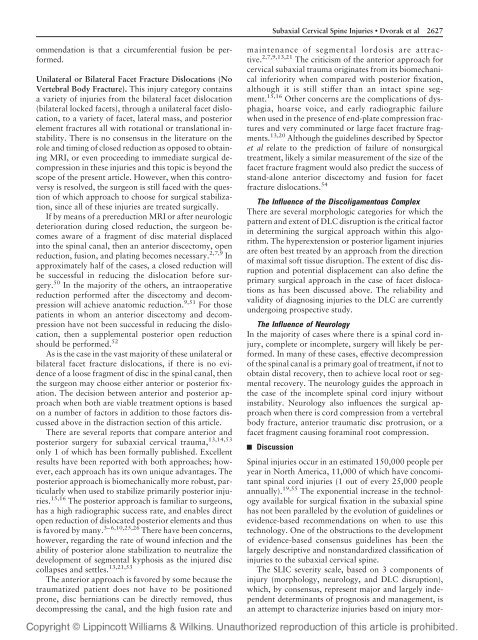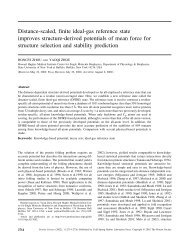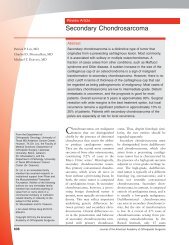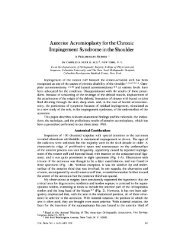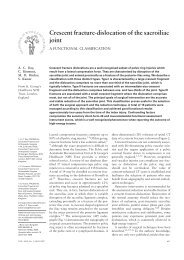The Surgical Approach to Subaxial Cervical Spine Injuries
The Surgical Approach to Subaxial Cervical Spine Injuries
The Surgical Approach to Subaxial Cervical Spine Injuries
You also want an ePaper? Increase the reach of your titles
YUMPU automatically turns print PDFs into web optimized ePapers that Google loves.
<strong>Subaxial</strong> <strong>Cervical</strong> <strong>Spine</strong> <strong>Injuries</strong> • Dvorak et al<br />
2627<br />
ommendation is that a circumferential fusion be performed.<br />
Unilateral or Bilateral Facet Fracture Dislocations (No<br />
Vertebral Body Fracture). This injury category contains<br />
a variety of injuries from the bilateral facet dislocation<br />
(bilateral locked facets), through a unilateral facet dislocation,<br />
<strong>to</strong> a variety of facet, lateral mass, and posterior<br />
element fractures all with rotational or translational instability.<br />
<strong>The</strong>re is no consensus in the literature on the<br />
role and timing of closed reduction as opposed <strong>to</strong> obtaining<br />
MRI, or even proceeding <strong>to</strong> immediate surgical decompression<br />
in these injuries and this <strong>to</strong>pic is beyond the<br />
scope of the present article. However, when this controversy<br />
is resolved, the surgeon is still faced with the question<br />
of which approach <strong>to</strong> choose for surgical stabilization,<br />
since all of these injuries are treated surgically.<br />
If by means of a prereduction MRI or after neurologic<br />
deterioration during closed reduction, the surgeon becomes<br />
aware of a fragment of disc material displaced<br />
in<strong>to</strong> the spinal canal, then an anterior discec<strong>to</strong>my, open<br />
reduction, fusion, and plating becomes necessary. 2,7,9 In<br />
approximately half of the cases, a closed reduction will<br />
be successful in reducing the dislocation before surgery.<br />
50 In the majority of the others, an intraoperative<br />
reduction performed after the discec<strong>to</strong>my and decompression<br />
will achieve ana<strong>to</strong>mic reduction. 9,51 For those<br />
patients in whom an anterior discec<strong>to</strong>my and decompression<br />
have not been successful in reducing the dislocation,<br />
then a supplemental posterior open reduction<br />
should be performed. 52<br />
As is the case in the vast majority of these unilateral or<br />
bilateral facet fracture dislocations, if there is no evidence<br />
of a loose fragment of disc in the spinal canal, then<br />
the surgeon may choose either anterior or posterior fixation.<br />
<strong>The</strong> decision between anterior and posterior approach<br />
when both are viable treatment options is based<br />
on a number of fac<strong>to</strong>rs in addition <strong>to</strong> those fac<strong>to</strong>rs discussed<br />
above in the distraction section of this article.<br />
<strong>The</strong>re are several reports that compare anterior and<br />
posterior surgery for subaxial cervical trauma, 13,14,53<br />
only 1 of which has been formally published. Excellent<br />
results have been reported with both approaches; however,<br />
each approach has its own unique advantages. <strong>The</strong><br />
posterior approach is biomechanically more robust, particularly<br />
when used <strong>to</strong> stabilize primarily posterior injuries.<br />
15,16 <strong>The</strong> posterior approach is familiar <strong>to</strong> surgeons,<br />
has a high radiographic success rate, and enables direct<br />
open reduction of dislocated posterior elements and thus<br />
is favored by many. 3–6,10,25,26 <strong>The</strong>re have been concerns,<br />
however, regarding the rate of wound infection and the<br />
ability of posterior alone stabilization <strong>to</strong> neutralize the<br />
development of segmental kyphosis as the injured disc<br />
collapses and settles. 13,21,53<br />
<strong>The</strong> anterior approach is favored by some because the<br />
traumatized patient does not have <strong>to</strong> be positioned<br />
prone, disc herniations can be directly removed, thus<br />
decompressing the canal, and the high fusion rate and<br />
maintenance of segmental lordosis are attractive.<br />
2,7,9,13,21 <strong>The</strong> criticism of the anterior approach for<br />
cervical subaxial trauma originates from its biomechanical<br />
inferiority when compared with posterior fixation,<br />
although it is still stiffer than an intact spine segment.<br />
15,16 Other concerns are the complications of dysphagia,<br />
hoarse voice, and early radiographic failure<br />
when used in the presence of end-plate compression fractures<br />
and very comminuted or large facet fracture fragments.<br />
13,20 Although the guidelines described by Spec<strong>to</strong>r<br />
et al relate <strong>to</strong> the prediction of failure of nonsurgical<br />
treatment, likely a similar measurement of the size of the<br />
facet fracture fragment would also predict the success of<br />
stand-alone anterior discec<strong>to</strong>my and fusion for facet<br />
fracture dislocations. 54<br />
<strong>The</strong> Influence of the Discoligamen<strong>to</strong>us Complex<br />
<strong>The</strong>re are several morphologic categories for which the<br />
pattern and extent of DLC disruption is the critical fac<strong>to</strong>r<br />
in determining the surgical approach within this algorithm.<br />
<strong>The</strong> hyperextension or posterior ligament injuries<br />
are often best treated by an approach from the direction<br />
of maximal soft tissue disruption. <strong>The</strong> extent of disc disruption<br />
and potential displacement can also define the<br />
primary surgical approach in the case of facet dislocations<br />
as has been discussed above. <strong>The</strong> reliability and<br />
validity of diagnosing injuries <strong>to</strong> the DLC are currently<br />
undergoing prospective study.<br />
<strong>The</strong> Influence of Neurology<br />
In the majority of cases where there is a spinal cord injury,<br />
complete or incomplete, surgery will likely be performed.<br />
In many of these cases, effective decompression<br />
of the spinal canal is a primary goal of treatment, if not <strong>to</strong><br />
obtain distal recovery, then <strong>to</strong> achieve local root or segmental<br />
recovery. <strong>The</strong> neurology guides the approach in<br />
the case of the incomplete spinal cord injury without<br />
instability. Neurology also influences the surgical approach<br />
when there is cord compression from a vertebral<br />
body fracture, anterior traumatic disc protrusion, or a<br />
facet fragment causing foraminal root compression.<br />
Discussion<br />
Spinal injuries occur in an estimated 150,000 people per<br />
year in North America, 11,000 of which have concomitant<br />
spinal cord injuries (1 out of every 25,000 people<br />
annually). 19,55 <strong>The</strong> exponential increase in the technology<br />
available for surgical fixation in the subaxial spine<br />
has not been paralleled by the evolution of guidelines or<br />
evidence-based recommendations on when <strong>to</strong> use this<br />
technology. One of the obstructions <strong>to</strong> the development<br />
of evidence-based consensus guidelines has been the<br />
largely descriptive and nonstandardized classification of<br />
injuries <strong>to</strong> the subaxial cervical spine.<br />
<strong>The</strong> SLIC severity scale, based on 3 components of<br />
injury (morphology, neurology, and DLC disruption),<br />
which, by consensus, represent major and largely independent<br />
determinants of prognosis and management, is<br />
an attempt <strong>to</strong> characterize injuries based on injury mor-


